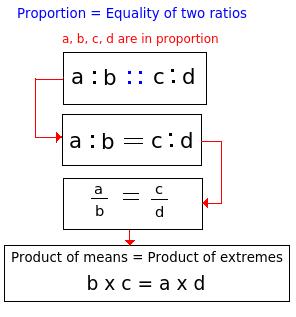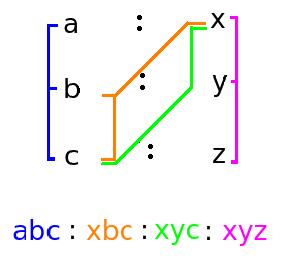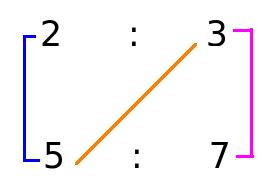Video on Ratio and Proportion - shortcuts, tips and tricksRatio and Proportion
Ratio:- The ratio of two quantities a and b of same units is the fraction x/y, where b ≠ 0
- The fraction x/y can be represented as x:y
Different types of ratios are:1) Duplicate ratio: It is the ratio of squares of two numbers.
| Duplicate ratio of the fraction | x | is given as: | x | = | x2 | or x : y = x2 : y2 |
| y | y | y2 |
2) Sub-duplicate ratio: It is the ratio between square roots of two numbers.
| Duplicate ratio of the fraction | x | is given as: | x | = | x | or x : y = x : y |
| y | y | y |
3) Triplicate ratio: It is the ratio of cubes of two numbers.
| Triplicate ratio of the fraction | x | is given as | x | = | x3 |
| y | y | y3 |
4) Sub- Triplicate ratio: It is the ratio between cube roots of two numbers
| Sub-Triplicate ratio of the fraction | x | is given as | x | = | x(1/3) |
| y | y | y(1/3) |
5) Compound ratio: It is the ratio of product of first terms in every ratio to that of product of second term in every ratio.
For example:
Compound ratio of (a : x), (b : y), (c : z) is (abc : xyz)
6) Inverse ratio: The ratio formed by interchanging their old places in the ratio to new
The inverse ratio of 5 : 8 is 8 : 5.
Proportion: 1) Proportion is the equality of two ratios.
When (a : b = x : y) is represented as (a : b :: x : y), then a, b, x, y are said to be in proportion.
In
(a : b :: x : y), a and y are called as
extremes and b and x are called as
mean terms. Product of means = Product of extremes2) Mean proportion: Mean proportion between x and y is given as
xy3) Third proportion: If p : q = q : s, then s is called as third proportional to p and q.
4) Fourth proportion: If u : v = x : y, then y is the fourth proportional of u, v and x.
Quick Tips and Tricks1) Comparison of ratios:| If (x : y) > ( a : b) → | x | > | a |
| y | b |
2) Proportion 4) Variation:
4) Variation:- If a = kb for some constant k, then we can say that a is directly proportional to b.
- If ba =k for some constant k, then we can say that a is inversely proportional to b.
5) If ratio between first and second quantity
m : n = a : x, second and third quantity
n : p = b : y, fourth and fifth quantity
p : q = c : z, then
m : n : p : q can be easily solved by using the trick shown below:
 m : n : p : q = abc : xbc: xyc : xyz6)
m : n : p : q = abc : xbc: xyc : xyz6) If a number a is divided in the ratio x : y,
| 2) Second part: | ay |
| (x + y) |
Question VarietyExamples:Q 1. If a : b = 2 : 3 and b : c = 5 : 7, then find a : b : c.
a. 12 : 15 : 9
b. 10 : 15 : 21
c. 14 : 12 : 21
d. 2 : 15 : 7
View solutionCorrect option : (b)
Here, to find a : b : c, use the trick discussed in quick tips and tricks.

a : b : c = (2 x 5) : ( 3 x 5) : (3 x 7) = (10) : (15) : (21)
If A : B : C = 3 : 4 : 7, then what is the ratio of (A / B) : (B / C) : (C / A)?
a. 63 : 48 : 196
b. 66 : 49 : 190
c. 56 : 40 : 186
d. 46 : 38 : 160
View solutionCorrect option : (a)
Hint: If a = kb for some constant k, then we can say that a is directly proportional to b.
A : B : C = 3 : 4 : 7
Assume, A = 3 k, B = 4 k, C = 7 k
Therefore,
| A | = | (3k) | , | B | = | (4k) | , | C | = | (7k) |
| B | (4k) | C | (7k) | A | (3k) |
| A | = | (3) | , | B | = | (4) | , | C | = | (7) |
| B | (4) | C | (7) | A | (3) |
L.C.M of 3, 4, 7 is 84
(3 x 84) / 4 = 63
(4 x 84) / 7 = 48
(7 x 84) / 3 = 196
Ratio of (A/B) : (B/C) : (C/A) = 63:48:196